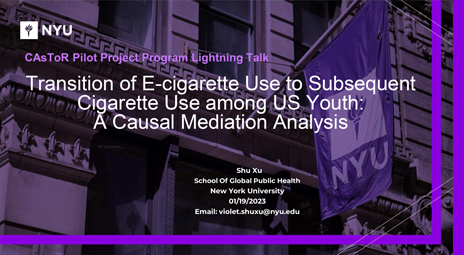“Identifying causal pathways in longitudinal tobacco product transition studies” with Dr. Shu “Violet” Xu (New York University)
- Contact the presenter
- Dr. Shu “Violet” Xu <sx5@nyu.edu>
- View Abstract +
- Prior studies have established an association between e-cigarette use in new tobacco users and subsequent uptake of cigarettes. Little is known, however, regarding mechanisms through which e-cigarette use leads to more severe tobacco use behaviors. The aim of this project was to use longitudinal data to evaluate whether and how initiators of e-cigarettes transition into more severe tobacco use behaviors. The data for the study were from the Population Assessment of Tobacco Research (PATH) study Waves 1 - 4. We conducted mediation analyses using the data from 7511 youth who initiated e-cigarette use or remained tobacco naive at Wave 2, reported harm perceptions of e-cigarette use at Wave 3 and current tobacco use at Wave 4. All potential confounders (e.g., demographics, drug use history, perception of harm) were reported at Wave 1. Among the 7.3% (n = 546) of youth who initiated e-cigarette use at Wave 2, 47.4% (n = 259) perceived e-cigarette use as less harmful than cigarette use at Wave 3, and 33.7% (n = 184) became current tobacco users at Wave 4. Among the 92.7% (n = 6965) of youth who did not initiate e-cigarette use at Wave 2, 27.5% (n = 1912) perceived e-cigarette use as less harmful than cigarette use at Wave 3, and 9.4% (n = 654) became current tobacco users at Wave 4 (reported past-30-day use of any tobacco products including e-cigarettes, traditional cigarettes, cigars, chewing tobacco/snuff/dip, hookah, roll-your-own cigarettes, pipes, snus, dissolvable, bidi, or heated tobacco). We used three estimation methods, the traditional mediation analysis, and two causal mediation analysis using resampling and weighting methods, to adjust for confounding in the causal pathways. The results of three methods consistently indicated that e-cigarette initiation is causally associated with lower perceived harm of e-cigarette use relative to cigarette use, which leads to subsequent current tobacco product use. Publications: Dr. Xu was the lead author of an article resulting from her pilot project work. The article, published in Prevention Science, is entitled “Relationships Between E-cigarette Use and Subsequent Cigarette Initiation Among Adolescents in the PATH Study: an Entropy Balancing Propensity Score Analysis”.
- View Bio +
- Dr. Xu is a Clinical Assistant Professor in the Department of Biostatistics, School of Global Public Health at New York University. She was trained as a Quantitative Psychologist focusing on longitudinal data analysis methodology. She completed her postdoctoral training in Prevention Methodology at the Methodology Center at Pennsylvania State University. After joining NYU, she has served as Investigator/Biostatistician on more than ten federally or locally funded research projects. Her research has focused on developing and applying statistical methods for longitudinal data, missing data, causal inference, and intervention program evaluation. She has rich experience in longitudinal data analysis, including analyzing data from the Population Assessment of Tobacco and Health (PATH) Study, which resulted in four peer-reviewed articles and two NIH-funded projects. She is PI of an NIH/NCI supplement award through the University of Michigan/Georgetown Center for the Assessment of the Public Health Impact of Tobacco Regulations (U54CA229974), and the project aims to examine the longitudinal effect of e-cigarette exposure on subsequent tobacco use patterns using conventional and causal mediation methods. She is also a co-Investigator of an NIH/NCI R21 award (1R21CA260423-01 PI: Jiang/Niaura). This project aims to assess the longitudinal impact of e-cigarette flavor, device, and marketing exposure on tobacco use and health outcome using propensity score weighting and causal mediation methods. She has published articles in leading statistical modeling journals (e.g., Structural Equation Modeling) and leading prevention science and tobacco control journals (e.g., Prevention Science, Nicotine and Tobacco Research, BMC Public Health). Dr. Xu’s profile at New York University.
 Dr. Shu “Violet” XuNew York University
Dr. Shu “Violet” XuNew York University
